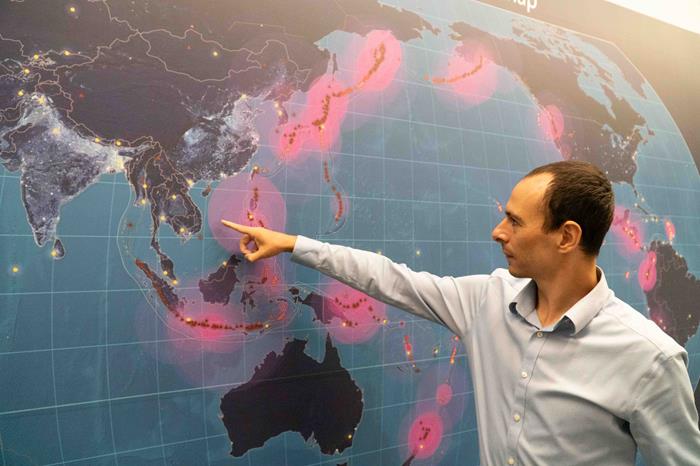Tens of thousands of submerged volcanoes lurk beneath the ocean's surface, often unnoticed and vastly understudied. These underwater giants, called volcanic seamounts, are generally not considered a significant threat due to their remote locations, but recent events revealed their catastrophic potential. In January 2022, the eruption of the Hunga Tonga – Hunga Ha’apai volcano, located in the southwest Pacific, unleashed the highest volcanic plume ever recorded, triggered tsunamis that traversed vast distances across the Pacific, and strongly impacted the Kingdom of Tonga. While we knew that the Tongan volcano was active, the threat from lesser-known seamounts in Southeast Asia is not as well understood. This is the topic of our recent study which assesses the hazards they pose to coastal communities and infrastructure.
We used a regional approach rather than only looking at specific seamounts to assess the combined hazard of all seamounts on Southeast Asian countries. In our study, which was published in Natural Hazard and Earth System Sciences, we compiled a list of over 450 submarine volcanoes in the waters of Southeast Asia, Taiwan, and Andaman and Nicobar Islands. We used published datasets of global undersea volcanoes and bathymetry data, which reveal the topography of seafloors and characteristics of the volcanoes, and we classified these volcanoes to understand how hazardous they could be.

Map showing the location of the subsea volcanoes in and around Southeast Asia, and the number of people living around them. (Source: Figure S2 (a) from the paper published in Natural Hazard and Earth System Sciences)
By looking at their shapes and heights, we identified four main morphologies: simple cones, composite edifice, calderas and guyots. Each morphology is due to a certain type of volcanic activity which informs about how hazardous the volcanoes can be. For example, simple cones that are deep (a few thousand metres deep) and small (a few hundred metres high) represent the least hazardous category. This is because their simple shape suggests a consistent and expected type of volcanic activity from an expected location, and because the high hydrostatic pressure at depth hinders explosive activity. In contrast, shallow and large calderas are potentially more hazardous, because the size, shape and low hydrostatic pressure indicate persistent, intense and potentially high explosive past volcanic activity.

Types of seamounts characterised by the study. One key example is caldera KW-23612 (bottom left), which may have catastrophic effects for the region in case of eruption. (Source: Figure 2 from the paper published in Natural Hazard and Earth System Sciences)
Past eruptions have shown that volcanic seamounts can generate a variety of hazards, and that they do not have to produce large volcanic plumes and tsunamis to affect us. For example, the Havre volcano, a volcanic seamount in the Kermadec Islands off the coast of New Zealand, erupted in 2012 and produced large amounts of floating rocks, or pumice rafts, in the Pacific Ocean, which were transported by currents and covered hundreds of squared kilometres of sea surface. These pumice rafts can disrupt ship traffic and affect local flora and fauna, as following the 2021 eruption from Fukutoku-Oka-no-Ba, a volcanic seamount located south of Japan.
We assessed the number and type of assets of each Southeast Asian country exposed to the hazards from the seamounts we classified, such as population, submarine communication cables, and ship traffic density, and found that a submarine volcanic eruption in the region would have greater impacts in Taiwan, Indonesia, Philippines and Vietnam.
We also found that some seamounts which have been inactive for years can still threaten the entire region. One example is a large caldera in the South China Sea, named KW-23612. This caldera is nearly 2800 metres (m) high and its summit is just 200 m below the sea surface. It is more than 7 kilometres (km) wide, which is more than double the size of the caldera of Mt. Pinatubo in the Philippines, which spew ash all over Singapore in 1991. Eruptions from such large volcanoes are rare but may cause powerful tsunamis spreading across the South China Sea and potentially affecting countries far away, such us Malaysia and Singapore.

Dr Andrea Verolino pointing at the location of a seamount he is studying. (Source: Kwok Kin Lee/Earth Observatory of Singapore)
Ile des Cendres volcano, located 100 km offshore southeast of Vietnam and closer to Singapore than KW-23612 in an area not expected to have active volcanoes, can also threaten Southeast Asia. This underwater volcano last erupted in 1923, produced a small tsunami that inundated the coasts of Vietnam, and formed several submarine cones and two volcanic islands which are now eroded.
Through this research, we hope to mitigate future volcanic hazards, and promote oceanic exploration and disaster preparedness. This can help safeguard coastal populations, and safeguard critical infrastructure against the looming threat of underwater volcanism.
More details about this study can also be found in this article by The Straits Times, where Dr Andrea Verolino discusses why it is crucial to study undersea volcanoes and their potential impacts.